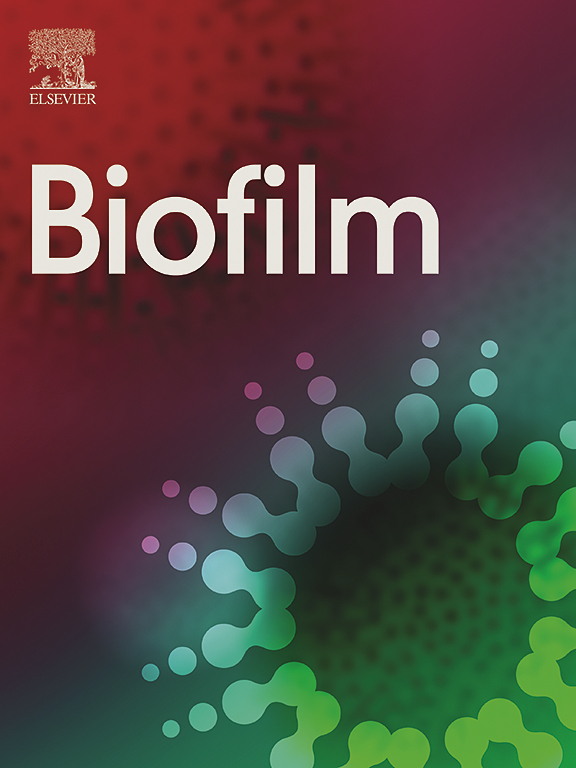Dynamic visualization of extracellular matrix components in S. aureus colony biofilms reveals functional amyloids leading to the formation of cap-like structures
IF 4.9
Q1 MICROBIOLOGY
引用次数: 0
Abstract
Staphylococcus aureus infections represent a clinical challenge due to their propensity to form biofilms and the increasing prevalence of antibiotic resistance. The ability of S. aureus to form biofilm affects clinical outcome, but techniques to study extracellular matrix (ECM) in S. aureus biofilms are lacking. Here, we present an agar-based method in which the optotracer EbbaBiolight 680 (Ebba680) is used to visualize ECM formation alongside evaluation of colony growth dynamics in agar colonies. As models for colony biofilms, we use drop inoculation for macrocolony formation or spread-plating for single-cell derived colonies. Kinetic fluorescence spectroscopy combined with time-lapse microscopy showed bright fluorescence signals, revealing different spatial-temporal appearance of ECM in macrocolonies versus single-cell derived colonies. In contrast, the microstructure was conserved between the two types of colonies. Detailed characterization of the biofilm microstructures by confocal microscopy revealed Ebba680 binding targets interspersed between cells as well as in a cap-like structure formed on the outer surface of the biofilm. Accessory gene regulator (agr) controlled expression of Ebba680 binding target(s) and the binding of Ebba680 to synthetic fibrillated phenol soluble modulins (fPSMs) suggests these functional amyloids act as targets for Ebba680 in the biofilm ECM. By upgrading ColTapp, an application developed for colony radius quantification, to also analyze fluorescence images, concurrent analysis of Ebba680-stained ECM and colony growth was achieved. This provided a new dimension to the assessment of colony biofilms. Detailed phenotypic characterization of clinical isolates is critical for treatment decision making, and enhanced screening which includes ECM as presented here has potential to facilitate treatment decisions in problematic staphylococcal infections.
金黄色葡萄球菌菌落生物膜胞外基质组分的动态可视化揭示了导致帽状结构形成的功能性淀粉样蛋白
金黄色葡萄球菌感染代表了一个临床挑战,由于他们倾向于形成生物膜和日益普遍的抗生素耐药性。金黄色葡萄球菌形成生物膜的能力影响临床结果,但研究金黄色葡萄球菌生物膜中的细胞外基质(ECM)的技术缺乏。在这里,我们提出了一种基于琼脂的方法,其中使用光示踪剂EbbaBiolight 680 (Ebba680)来可视化ECM的形成,并评估琼脂菌落的菌落生长动态。作为集落生物膜的模型,我们使用滴接种来形成大集落,或使用扩散镀来获得单细胞衍生的集落。动态荧光光谱结合延时显微镜显示了明亮的荧光信号,揭示了大菌落与单细胞衍生菌落中ECM的不同时空外观。相比之下,两种菌落之间的微观结构是保守的。通过共聚焦显微镜对生物膜的微观结构进行了详细的表征,发现Ebba680结合靶点分布在细胞之间以及生物膜外表面形成的帽状结构中。辅助基因调节因子(agr)控制Ebba680结合靶点的表达,以及Ebba680与合成纤维化酚溶性调节素(fpms)的结合,表明这些功能性淀粉样蛋白在生物膜ECM中作为Ebba680的靶点。通过升级ColTapp(一款用于菌落半径量化的应用程序)来分析荧光图像,可以同时分析ebba680染色的ECM和菌落生长。这为菌落生物膜的评价提供了一个新的维度。临床分离株的详细表型特征对治疗决策至关重要,而包括ECM在内的强化筛查有可能促进问题葡萄球菌感染的治疗决策。
本文章由计算机程序翻译,如有差异,请以英文原文为准。
求助全文
约1分钟内获得全文
求助全文

 求助内容:
求助内容: 应助结果提醒方式:
应助结果提醒方式:


